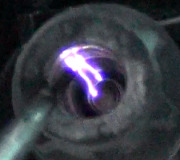NO START CONDITION
Disconnect secondary coil wire from distributor. While holding wire approximately 1/4" away from engine ground, crank engine. If there is constant spark, slowly move secondary coil wire away from ground while watching coil tower for arching. If arching occurs replace coil. If there is no spark or spark is not constant, go to step 3). If spark is good, go to next step.
The secondary ignition system is producing the necessary high secondary voltage. Ensure voltage is getting to the spark plugs by checking rotor, cap, spark plug wires, and spark plugs. If these components are okay, ignition system is not the cause of the no start condition. Check fuel system and engine mechanical functions.
Ensure sufficient battery voltage (12.4 volts) is present for cranking and ignition systems. Crank engine for 5 seconds while monitoring voltage at coil positive terminal. If voltage remains near zero during length of time cranking, see NO START TEST NO. 15 (turbo) or NO START TEST NO. 17 (non-turbo) for checking ASD relay and refer to NO START TEST NO. 15 (turbo) or NO START TEST NO. 3 (non-turbo) for checking SMEC in appropriate article in COMPUTERIZED ENGINE CONTROLS section.
If close to battery voltage but drops to zero after 1-2 seconds of cranking, see NO START TEST NO. 16 for checking distributor reference pickup circuit to SMEC in appropriate article in COMPUTERIZED ENGINE CONTROLS section. If voltage remains close to battery voltage for entire 5 seconds, turn ignition off. Remove 14-pin connector from SMEC. Ensure terminals of 14-pin connector are not damaged causing a poor connection.
Disconnect ignition coil positive lead. Connect a jumper wire between coil positive terminal and battery positive terminal. Using a jumper wire with a.33 microfarad capacitor, momentarily ground terminal No. 12 of 14-pin connector. See Fig. 1. A spark should be seen when ground connection is removed
Tuesday, July 27th, 2010 AT 2:26 PM



